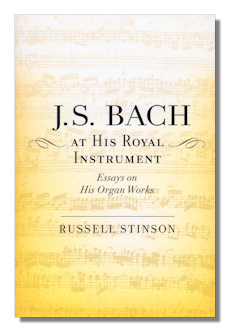
The Internet's Premier Classical Music Source
Related Links
-
Introduction
Acoustics
Ballet
Biographies
Chamber Music
Composers & Composition
Conducting
Criticism & Commentary
Discographies & CD Guides
Fiction
History
Humor
Illustrations & Photos
Instrumental
Lieder
Music Appreciation
Music Education
Music Industry
Music and the Mind
Opera
Orchestration
Reference Works
Scores
Thematic Indices
Theory & Analysis
Vocal Technique
Search Amazon
Recommended Links
Site News
 Book Review
Book Review
J.S. Bach at His Royal Instrument

Essays on His Organ Works
Russell Stinson
Oxford University Press, 2012 pp vii + 203
ISBN-10: 019991723X
ISBN-13: 978-0199917235
Russell Stinson is the Josephine Emily Brown Professor of music at Lyon College in Batesville, Arkansas. He's also the College's organist; and has written a handful of distinguished books on Bach's compositions for, and work with, the organ. In this relatively short (at barely 150 substantive pages) new book from OUP he presents two dozen or so closely-argued essays on a variety of aspects of Bach's work with and for the instrument.
It's not a neglected area by any means, of course. But Stinson has added nicely to what's available. In seven sections he turns his attention to the reception of Bach's organ works… how they've been understood, performed, interpreted and adapted by musicians from Bach's contemporaries to those active in recent decades.
Two aspects of J.S. Bach at His Royal Instrument are likely to strike you. First, the thoroughness and meticulousness of Stinson's approach. Secondly, the way he sweeps up three key areas of Bach's work in the field; then successfully combines. These are: a survey of recent advances in understanding of Bach and the organ; some corrections of (mis)perceptions about the field; and in depth exposition of such recherché areas as César Franck's performing and compositional response to the organ work of Bach, and that of more recent composers like Parry, Busoni, Honegger and even Wagner.
The extent to which Bach's organ compositions influenced specifically Mendelssohn, Schumann and Elgar is also surveyed. Schübler receives special attention, understandably. Although none of the essays is long (they range from one or two to a dozen pages or more in length), they're packed with detail. Footnotes are on the page; there are both substantial appendices (expanding on and supporting the portion of the book dealing with Franck) and a good index. The tables and musical examples are easy to read; (cross-)referencing is thorough and helpful. There is an unannotated bibliography of the works which Stinson has used to compile and order his content.
Stinson is nothing if not ambitious in this book: although the material is focused, condensed and distilled, he sets himself the task of reviewing all of Bach's output for the "king or instruments" (hence the book's title). He explains and provides convincing and informative commentaries on the stylistic and contextual nature of Bach's organ works in such a way that the variety of responses which they have received since their composition comes as no surprise. Similarly, Stinson deals with Mendelssohn as performer (of Bach's organ works), Schumann as critic and editor, Franck as performer and teacher, and Elgar as performer, critic and transcriber. Bach's organ works indeed present a wealth of possibilities; drawing these out is a worthwhile aim of the book – and one amply achieved.
Stinson adds anecdotes, quotes, and contemporary accounts to his factual material. This helps to make the at times potentially dense ground nevertheless approachable and accessible. The introductory survey itself makes the book almost essential for organists, Bach lovers and musicians alike, for this is a constantly developing area. What's more, Stinson's understanding of the issues, of the body of existing research and received wisdom (some of it "amended" here) makes for stimulating and informative reading.
J.S. Bach at His Royal Instrument is not an expensive book. It sets an interesting and important goal – to survey a core area of the repertoire in the light of the ways in which it has been approached since it was written. Stinson does this very well indeed; he has aimed at more than one readership. And has succeeded on all counts.
Copyright © 2013 by Mark Sealey.



















